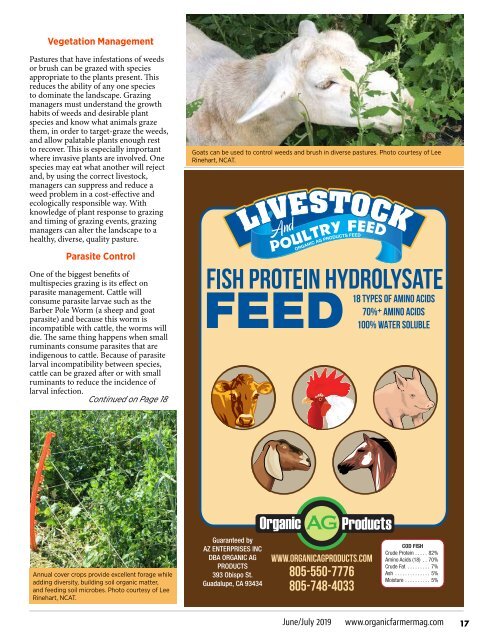Organic Farmer June 2019
You also want an ePaper? Increase the reach of your titles
YUMPU automatically turns print PDFs into web optimized ePapers that Google loves.
Vegetation Management<br />
Pastures that have infestations of weeds<br />
or brush can be grazed with species<br />
appropriate to the plants present. This<br />
reduces the ability of any one species<br />
to dominate the landscape. Grazing<br />
managers must understand the growth<br />
habits of weeds and desirable plant<br />
species and know what animals graze<br />
them, in order to target-graze the weeds,<br />
and allow palatable plants enough rest<br />
to recover. This is especially important<br />
where invasive plants are involved. One<br />
species may eat what another will reject<br />
and, by using the correct livestock,<br />
managers can suppress and reduce a<br />
weed problem in a cost-effective and<br />
ecologically responsible way. With<br />
knowledge of plant response to grazing<br />
and timing of grazing events, grazing<br />
managers can alter the landscape to a<br />
healthy, diverse, quality pasture.<br />
Goats can be used to control weeds and brush in diverse pastures. Photo courtesy of Lee<br />
Rinehart, NCAT.<br />
Parasite Control<br />
One of the biggest benefits of<br />
multispecies grazing is its effect on<br />
parasite management. Cattle will<br />
consume parasite larvae such as the<br />
Barber Pole Worm (a sheep and goat<br />
parasite) and because this worm is<br />
incompatible with cattle, the worms will<br />
die. The same thing happens when small<br />
ruminants consume parasites that are<br />
indigenous to cattle. Because of parasite<br />
larval incompatibility between species,<br />
cattle can be grazed after or with small<br />
ruminants to reduce the incidence of<br />
larval infection.<br />
Continued on Page 18<br />
Annual cover crops provide excellent forage while<br />
adding diversity, building soil organic matter,<br />
and feeding soil microbes. Photo courtesy of Lee<br />
Rinehart, NCAT.<br />
<strong>June</strong>/July <strong>2019</strong><br />
www.organicfarmermag.com<br />
17


















